Spring means rhubarb, and rhubarb means memories
Think celery with attitude, or maybe a vintage laxative
Fresh from the garden and dipped in sugar
One of my core childhood memories is hopping off Bus #26 on spring afternoons and running to Dad’s little garden to yank up a stalk of pink rhubarb. After wiping the dirt off on my school clothes, I’d rush into the house, rinse the U-shaped stalk half-heartedly under the kitchen faucet, then head to the sugar bowl I kept in the corner next to the breadbox for just such occasions.
Since my culinary treasure was still damp from its recent shower, I’d dip the end directly into the bowl of white sugar, making sure every nook and cranny was covered, and then chomp away.
Did I double-dip?
Absolutely!
If you’ve never tasted fresh-from-the-garden rhubarb, you’re missing out. It is crisp like celery but, instead of being bland and boring, fresh rhubarb is tart to the point of fearing that your jaw might permanently lock up with that first delicious bite.
And sometimes it will.
Sometimes there are shivers.
Sometimes tears, as well, because your eyelids automatically squeeze shut so tightly that all the eye juices in there have to get out of the way: there’s simply no room for them to stay.
But then the sugar kicks in.
The tartness of the rhubarb has shocked your salivary glands into action, and the sugar crystals start to dissolve.
The result isn’t a dance, and it isn’t a battle, but it is definitely energetic. Remember the first time you tried Pop Rocks? There are definite similarities.
After the second or third swipe through the sugar bowl and subsequent chomp, your tastebuds calm down, adapt a little, and the tartness fades, if not into the background, at least into equilibrium with the sugar.
Which, in my opinion, is the exact moment when the humble rhubarb becomes the best spring snack in the universe, whether you’re a kid running off the school bus, or a 63-year-old woman waiting for the first rhubarb of the season to pop up at her local market and say hello.

Rhubarb is an enigma.
Enigma: difficult to interpret or understand; mysterious.
A quick internet search for “rhubarb recipes” yields an unending assortment of options, nearly all of which would fall into the “dessert” category in most cookbooks. That makes sense, I suppose. Rhubarb is, undoubtably, a fruit, and fruits spend more time in desserts than vegetables, right? (Sorry pumpkin pie lovers!)
Absolutely wrong!
It turns out rhubarb is a vegetable, a stalk vegetable, to be more specific, the same category of vegetables as celery, asparagus, Swiss chard, artichokes, bok choy, green onions, leeks, bamboo shoots and cauliflower.
It is also a medicinal plant.
Dried rhubarb roots have been used as a gentle laxative in Chinese medicine for five thousand years, and by Roman and Greek physicians as both an antiseptic and a laxative some three thousand years later.
Rhubarb roots were also well-known for their medicinal properties in the American colonies, however much, much later. A 1728 article in the Pennsylvania Gazette suggests rhubarb roots could be administered to a pregnant woman experiencing signs of a miscarriage, specifically if she had “a continu’d Desire of going to Stool”. 4
It could also be used as a preparation for a Small Pox inoculation, at least according to London physician, William Heberden in 1760.
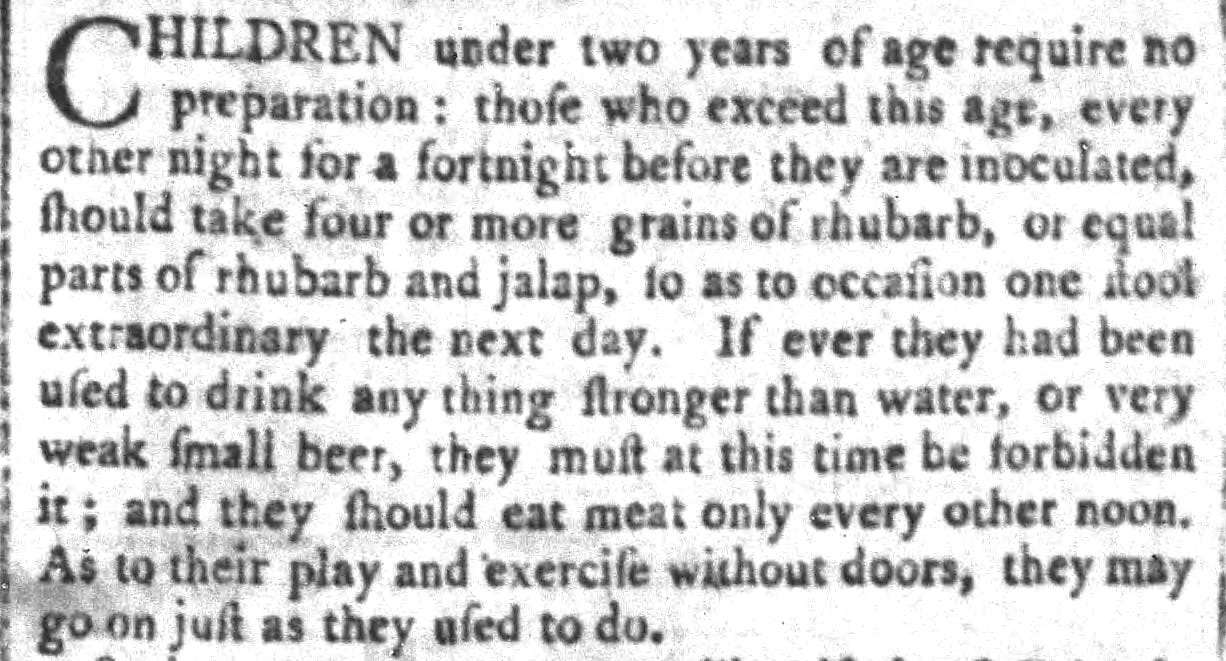
Despite its popularity in medical and veterinary circles — it was also used to treat distemper in cattle — rhubarb still had to be imported into the Colonies, most often from the England, as seen in this ad found in the South Carolina Gazette.
All that began to change, however, after the Revolutionary War. American horticulturists started looking into the possibility of large scale cultivation of rhubarb, much in the same way as it had been successfully introduced into other places around the world.
It has often been remarked that in time United North-America will be Russia’s formidable rival in all the branches of her exporting trade. In 1761, 20,000 sterling with of [rhubarb root] was imported from Russia into Great Britain; In 1779, the Botanic garden in Edinburgh was stocked with 3,000 plants, the greatest part of them 6 and 7 years old. Since 1769, the genuine Oriental Rhubarb, as well as other species, are planted on a tract of land of about 30 acres, in Kaefern-Thal, in the Palatinate. A few kernels imported from Petersburg by ProfessorBergius, gave rise to considerable plantations of this precious root in Sweden; their produce was tried by the medical faculty of Stockholm, and found to be qual in efficacy to the real Tartarian Rhubarb. 5
Today, more than 1,200 acres of rhubarb are cultivated in America, primarily in Washington, Oregon, and Michigan, but also in places like Wisconsin and Minnesota, where countless families like mine have been growing, eating and enjoying rhubarb from their private rhubarb patches for decades. 6
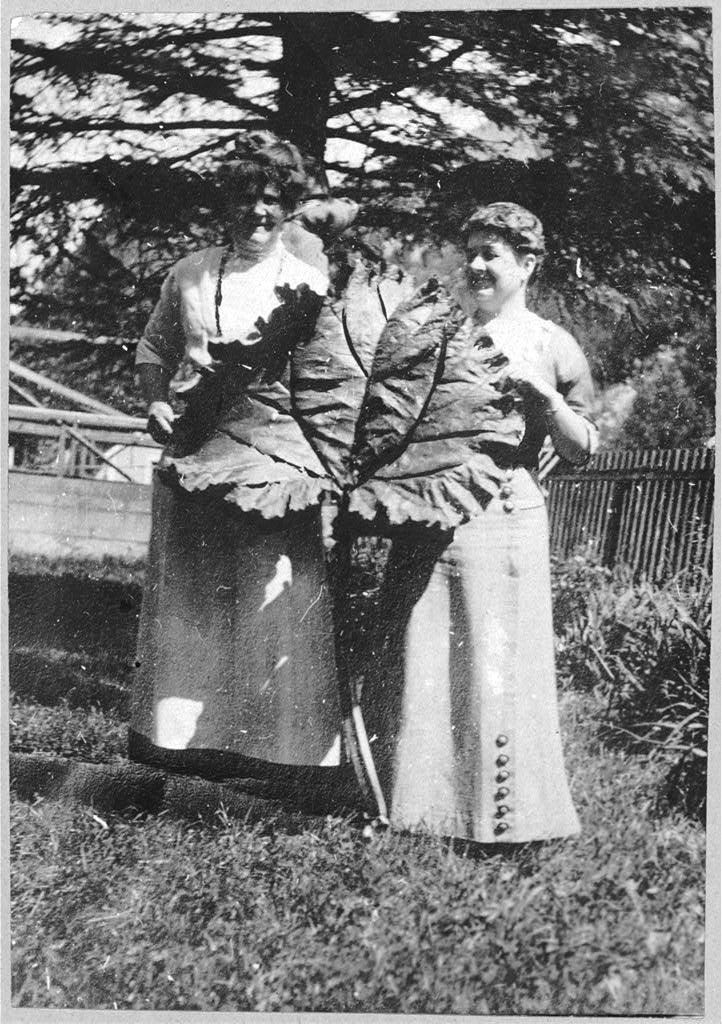
Beware those leaves
I grew up being told rhubarb leaves were toxic. In fact, my parents insisted I wash my hands after touching the big, frilly leaves just in case. Turns out they weren’t wrong, although the hand washing was a wee bit over the top.
Rhubarb leaves contain high concentrations of oxalic acid and when humans ingest oxalic acid there can be some pretty nasty results — everything from red-colored urine, eye pain and burning sensations in the mouth and throat; to seizures, kidney stones, coma, kidney failure and, although very, very rarely, even death.
So, don’t get all creative and think you can add rhubarb leaves to your next culinary creation
Springtime memories made of rhubarb
When springtime rolls around, I start dreaming of rhubarb. For a long time, I assumed everyone dreamt of rhubarb in the spring. Everyone in my family did, our neighbors did, kids at my school did. Heck, even the school lunch ladies did — why else would we get rhubarb cake with our grilled cheese sandwiches and tomato soup the last three months of the school year?
Then I married my husband. Born and raised in Texas, he’d never even seen a stalk of rhubarb, much less tasted one.
Bless his heart.
When this gross deficiency in his culinary history came to the forefront, I knew what I needed to do — make my grandma’s Rhubarb and Cherry Crunch. There was just one problem: it was winter.
No fresh rhubarb in the garden.
No canned rhubarb in the pantry.
No rhubarb anywhere.
For the next few weeks, I scoured every grocery store and market in a 10-mile radius, but came up empty.
Then one day, buried beneath three packages of frozen strawberries and a bag of frozen peaches and stuffed into the corner of a large freezer at Safeway, I struck gold. Or rather pink — a yet-to-be-expired bag of frozen rhubarb.
Grabbing the remaining ingredients of Grandma’s world famous Rhubarb and Cherry Crunch, I flew through the checkout process, and quickly made my way home. If everything went right, I’d have a pan of warm, bubbly rhubarb goodness ready by the time Jerry walked in the door from work.
And I did.
To my credit, I didn’t love bomb Jerry with Grandma’s crunch right away, but it didn’t take too long before I had a still-warm piece on a plate in front of him. As I handed him his fork, I was giddy with expectation. It’s not every day you get to introduce another person to a food so delicious, meaningful and culinarily foundational as rhubarb, after all.
As the man I love took that all important first bite, I envisioned a halo of sweet aroma circling around him, the delicate pink of rhubarb shyly peeking out through perfectly toasted oatmeal topping, plump cherries waiting in the wings.
I remembered early spring mornings when Dad and I would go out to the garden to check the plants, the after school snacks of sun-warmed rhubarb dipped in sugar, picking and then bundling the pink stalks to take to my grandparent’s house where Grandma would turn them into something magical. The last rhubarb cake of the season covered in mountains of vanilla ice cream.
Food is more than the things we eat. It is the people whose hands have touched it, the laughter shared over it, the memories made because of it. Food is the keeper of our most sacred stories, and when we share it with others, we gift them bite-sized tastes of who we are and where we came from.
The day I made Grandma’s rhubarb crunch for my husband is part of my culinary story now, and part of his, as well. We might tell it differently — I remember the anticipation and joy, and he may better recall the initial trepidation and tartness, but its a memory we laugh over more often than you might think, and one we both cherish.
It is also a memory we build on each year right around this time, as the tender stalks of rhubarb pop their heads up out of the black dirt — a promise of deliciousness to come and new memories made.
Copyright 2025 Lori Olson White
Please hit the ❤️ button at the bottom of the page to help this story reach more readers. And if you’re not already a subscriber, I’d love to have you join me. Thanks!
Although most of the time I try to include just a couple of recipes, there are just so many wonderful ways to use rhubarb that I had a hard time choosing! Although the first recipe is a treasured family. favorite, the others are all taken from vintage Minnesota cookbooks and newspapers, and all but the Rhubarb Log are pieces of my own culinary heritage, of not in exact measure, most definitely in memory.
Elvira’s Rhubarb & Cherry Crunch
Crust
1 cup quick oatmeal
1 cup brown sugar
pinch of salt
1 cup flour
1/2 cup butter
Filling
4 cups diced rhubarb
1 cup sugar
1 cup water
2 Tbs corn starch
1 tsp almond flavoring
1 can cherry pie filling
1/2 cup chopped almonds
a few drops of red food coloring (optional)
Instructions
Mix oatmeal, brown sugar, salt, flour and butter together. Press half in the bottom of a 9x13-inch pan. Dice rhubarb and place on top of crust. Boil sugar, water and cornstarch together until thick. Add cherry pie filling, and a few drops of red food coloring if needed. Pour mixture over rhubarb. Sprinkle with chopped nuts. Chill one hour. Serve with ice cream of whipped cream.
Rhubarb relish
Ingredients:
Two pounds rhubarb, one-fourth pound seeded and chopped raisins, one-half pound stoned and chopped dates, three cups vinegar, two pounds light brown sugar, one tablespoon chili peppers, one and one-half tablespoon salt, one teaspoon ginger, one-half cup English walnuts.
Instructions:
Combine dates and raisins and let stand in vinegar for one hour. Skin rhubarb and cut in half-inch pieces,, Add to first mixture with all the remaining ingredients except the nuts. Cook slowly stirring frequently for two hours. Add nuts and cook 10 minutes longer. Turn into sterilized jelly glasses and cover with paraffin. 1
Rhubarb, orange and prune marmalade
Ingredients:
7 cups rhubarb, cut fine
8 lbs. sugar
2 lbs. prunes, cooked and cut fine
2 oranges, pulp and grated rins
Instructions:
Combine and cook until rhubarb is tender, then simmer until thick, about 20 minutes. Pour into jars and seal. 2
Savory rhubarb log
“As one of the cheerriest assurances of spring, rhubarb always receives a warm welcome at its first appearance, whether on the market or in the family garden.
The recipe for rhubarb logs, which may be served as a dessert or a meat accompaniment, uncloses the delicious natural flavor of rhubarb in a crunchy golden brown crust.”3
Ingredients:
One and three-fourths cups all purpose flour, 5 tablespoons granulated sugar, 1 tablespoon baking powder, 1/8 teaspoon salt, one egg well beaten, 1 cup milk, 1 tablespoon melted shortening, 1 1/2 pounds young, tender rhubarb.
Instructions:
Sift dry ingredients together. Combine beaten egg with milk and add to dry ingredients gradually. Add melted shortening and mix lightly. Wash and dry rhubarb stalks. Cut into 4-inch length. Dip each into the batter and then fry in deep hot fat (360 degrees F) until golden brown, about 5 minutes. Drain thoroughly on brown paper. Roll in powdered sugar if they are to be used as dessert. Serve hot. Makes 24 logs.
Your turn and your culinary traditions
What’s the first food or dish that signals the arrival of spring for you? Why does it feel like the true start of the season?
Did your family have a specific food tradition tied to springtime? A special dessert, a yearly gathering, or a ritual around planting, harvesting, or cooking?
Have you ever picked or foraged for a spring ingredient, like rhubarb, asparagus, or morel mushrooms? What was that experience like, and who was with you?
Is there a particular springtime dish you make (or someone in your family made) every year? What memories are baked, stirred, or simmered into it?
Spring is a time of renewal and gathering. Can you recall a time when you shared a homemade spring dish with someone—a friend, neighbor, or family member? How did they react?
Think back to your childhood. Was there a spring food that you loved (or disliked) but now appreciate in a new way? What changed?
Describe a moment of cooking or baking in the springtime—what scents, sounds, and feelings do you associate with it? Who taught you how to make that dish?
How does the change in weather affect what you crave in the spring? Do you shift from hearty winter meals to lighter, fresher dishes? What flavors define the season for you?
Have you ever grown an ingredient that became part of a springtime meal? If not, what would you love to grow and cook with?
If you could choose one spring food tradition to share with the next generation, what would it be? How would you pass down not just the recipe, but the meaning behind it?
Do you have a favorite potato salad recipe or story?
Hey, all! I’m still collecting family potato salad recipes and stories thru May 1, so if you haven’t gotten around to sharing yours, there’s still time!
You can send me a link to something you’ve previously written or send me a newly-written story and recipe via DM
I’ll compile them all, and share it as a free shareable PDF May 16 - just in time for Memorial Day, the official start of the picnic season here in the US.
Thanks to all of you who’ve already shared your potato salad recipes and stories - they’re fabulous!
If you missed it, here’s the story that started this little project:
In case you missed it
If stories at the intersection of food and family history are what you’re looking for, look no further than our archives! Here are a few of our favorites.
Culinary History is Family History is reader-supported. When you buy through links on our site, we may earn an affiliate commission.
End Notes:
1 “Rhubarb helps to stretch fresh fruits in preserves”, The Duluth News Tribune, Duluth, MN, May 17, 1936, P. 5.
2 “Recipe Round-up by Nancy Nahsen: Rhubarb Marmalade”, The Austin Daily Herald, Austin, MN, May 14, 1955, P. 4.
3 “Rhubarb responds to wide variety of uses”, The Minneapolis Journal, Minneapolis, MN, May 10, 1935, P. 22.
4 “Abortion in Medicine”, The Pennsylvania Gazette, Pennsylvania Colony, November 21, 1728, P. 1.
5 “Occasional Thoughts on Rhubarb”, Poulson’s American Daily Advertiser, April 10, 1789, P. 3.
6 “Rhubarb” https://www.tridge.com/intelligences/rhubarb.

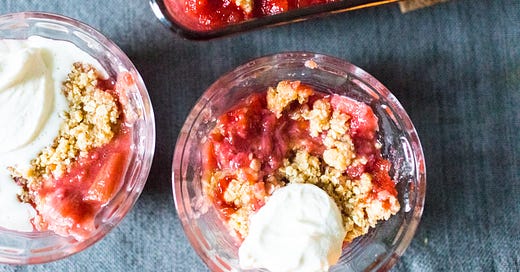


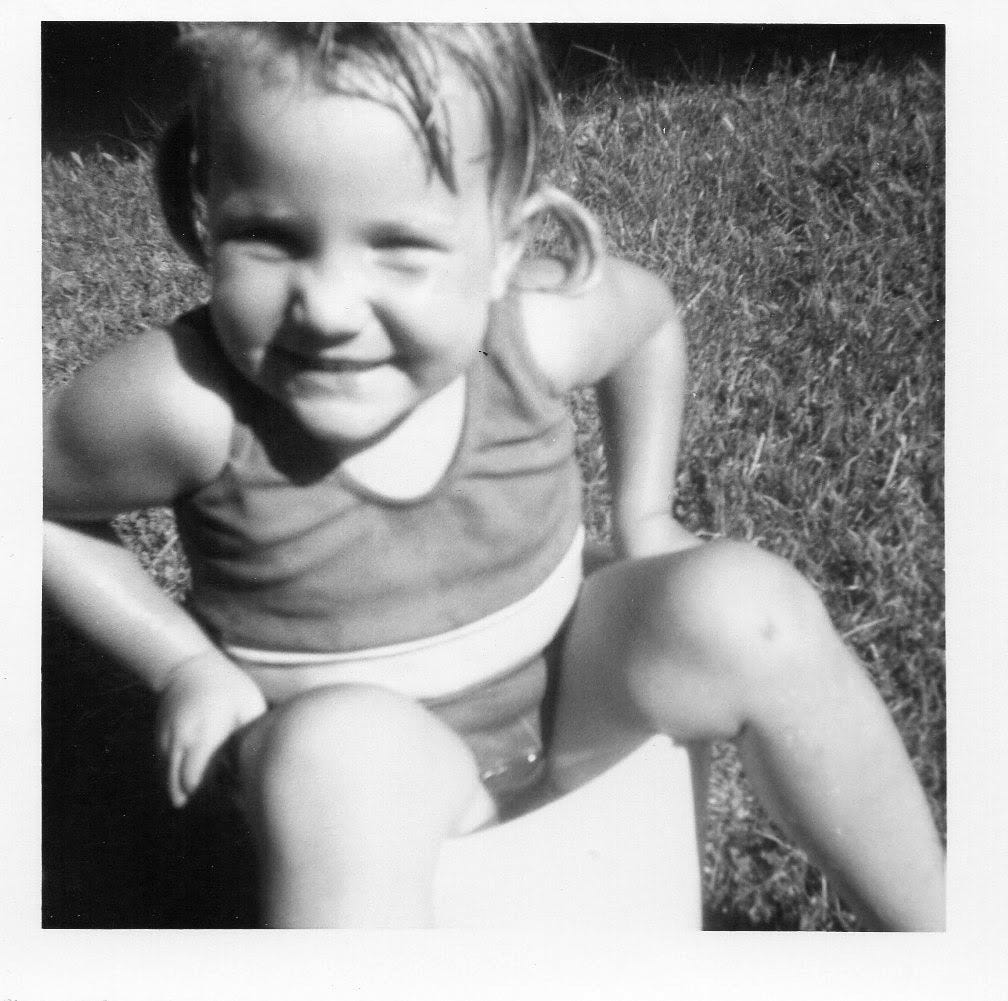


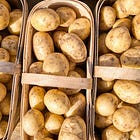
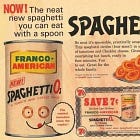

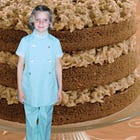
I have always loved Rhubarb! Eating it raw covered in sugar is new to me ... Not something I have done. I have only eaten it either as a component of a chutney or stewed for breakfast (eaten with cereal) or for dessert either on its own (with icecream), or in pie or crumble (also with icecream ... or custard ... or both).
The only thing I knew rhubarb was good for was strawberry rhubarb pie, which was okay, but I never craved it. The rhubarb grew wild along the railroad tracks in Wilbraham, Massachusetts, and some years my mother would pick it and make a pie.